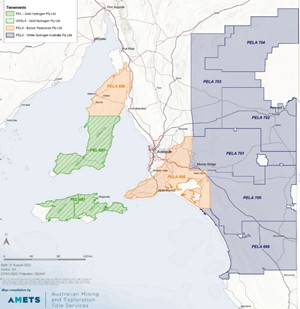News
Airborne geophysical survey to identify new natural H2 targets in the Ramsay Project
Gold Hydrogen has contracted Xcalibur Multiphysics to acquire a non-invasive 10,529-line km at 500-meter spacing airborne gravity-magnetic-digital terrain model survey across the mainland component of Ramsay Project in South Australia. The company has also received approval for the survey from the South Australian Government Department for Energy and Mining under Section 74(3)(a) of the South Australian Petroleum and Geothermal Energy Act 2000.
The non-invasive airborne survey is scheduled to commence in late March 2023. Xcalibur provides fast and efficient data acquisition of passive gravity and magnetic geophysical data. The Xcalibur magnetic and gravity tools rely on no controlled sources but seek out naturally occurring variations in the Earth’s gravity and magnetic fields.
This high-resolution geophysical data will support building up from the foundation of the historical data sets which helped define the current Prospective Resources, and geology around the documented natural H2 occurrences in the Ramsay Oil Bore 1 and American Beach Oil 1 wells located in PEL 687. Gases were sampled by the State of South Australia at the rig sites of these wells at the time, and by later laboratory analysis it was determined that these gases had a very high natural H2 content of between 66% and 89%.

The acquisition of this new data is also a valuable exploration tool in defining additional new subsurface structures and differentiating rich natural H2 source rocks around and away from the historic Ramsay Oil Bore 1 and American Beach Oil 1 wells. Upon completion of processing, the new data will be integrated with the reprocessed 2D seismic, completed in December 2022, and integrated with Gold Hydrogen’s static and dynamic subsurface models developed with Schlumberger and Total Seismic.
As further new data is collected, including gas-soil surveys and data from new drilling scheduled to commence in Q3, 2023, these models will become a strategic tool for high-grading potential areas for further seismic acquisition, play, lead, and prospect analysis, new drilling and associated production testing to support maturing the company’s independently assessed Prospective Resource, advancing the title to a production license, and generating a field development plan.
Gravity readings on Earth are not the same everywhere. Gold Hydrogen is looking for the rocks underfoot that are relatively dense and heavy. These gravity highs are likely associated with iron-rich source rocks and gravity lows associated with low iron content source rocks or country rocks. Similarly, high magnetic anomalies are typically related to iron-rich rocks and useful for also delineating faults and contacts between different rock-types.
Areas with both high gravity and high magnetic anomalies are likely associated with denser and more iron-rich rock-types, such as the natural H2 source rocks of the Hiltaba and Wallaroo, which are considered to be highly prospective in the company’s 100% operated Ramsay Project.
Following the acquisition of the data, which is expected to take three weeks, workflows involving processing will produce a range of grids that will support the generation of litho-structural interpretations. Often after this final interpretation is complete, the resulting elevated subsurface definition across the surveyed area can be broken down into geological domains, prioritized by prospectivity, and also act as guide for future activities to be less impactful to surface owners and the community.


